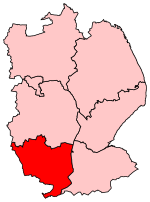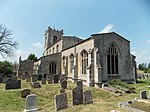Swinstead

Swinstead is a village and civil parish in the South Kesteven district of Lincolnshire, England. It is situated 5 miles (8.0 km) west from Bourne, 9 miles (14.5 km) north from Stamford and 11 miles (17.7 km) south-east from Grantham. It is a village of just over 100 households, the population of the civil parish being measured at 234 in the 2011 census. Swinstead parish church is dedicated to St Mary. The village's last public house closed in 2008, and the nearest amenities are 2 miles (3.2 km) away at Corby Glen. Adjacent villages include Creeton, Swayfield and Grimsthorpe. England international footballer Beaumont Jarrett was vicar of Swinstead from 1883 to 1895.In William Shakespeare's King John, King John stayed in "Swinsted Abbey", but it is Swineshead Abbey that he stayed: this confusion was common in late-sixteenth century texts, for Swinstead is about 25 miles from Swineshead.
Excerpt from the Wikipedia article Swinstead (License: CC BY-SA 3.0, Authors, Images).Swinstead
High Street, South Kesteven Swinstead
Geographical coordinates (GPS) Address Nearby Places Show on map
Geographical coordinates (GPS)
| Latitude | Longitude |
|---|---|
| N 52.79047 ° | E -0.492239 ° |
Address
High Street
High Street
NG33 4PN South Kesteven, Swinstead
England, United Kingdom
Open on Google Maps










